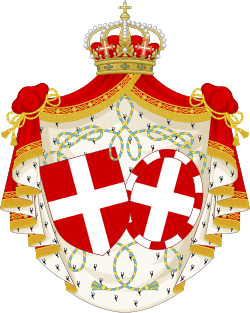Margherita of Savoy
| Princess Margherita | |||||
|---|---|---|---|---|---|
 | |||||
| Queen consort of Italy | |||||
| Tenure | 9 January 1878 – 29 July 1900 | ||||
| Born | 20 November 1851 Palazzo Chiablese, Turin, Kingdom of Sardinia | ||||
| Died | 4 January 1926 (aged 74) Bordighera, Italy | ||||
| Burial | |||||
| Spouse | Umberto I of Italy | ||||
| Issue | Victor Emmanuel III | ||||
| |||||
| House | House of Savoy-Genoa (by birth) House of Savoy (by marriage) | ||||
| Father | Prince Ferdinand, Duke of Genoa | ||||
| Mother | Princess Elisabeth of Saxony | ||||
| Styles of Queen Margherita | |
|---|---|
 | |
| Reference style | Her Majesty |
| Spoken style | Your Majesty |
| Alternative style | Ma'am |
Princess Margherita of Savoy (Margherita Maria Teresa Giovanna; 20 November 1851 – 4 January 1926), was the Queen consort of the Kingdom of Italy during the reign (1878–1900) of her husband, Umberto I.
Family
She was a daughter of Prince Ferdinand, Duke of Genoa and Princess Elisabeth of Saxony.
She married her first cousin Umberto, Prince of Piedmont, on 21 April 1868. On 11 November 1869, Margherita gave birth to Victor Emmanuel, Prince of Naples, later Victor Emmanuel III of Italy. He was their only child.
Queen consort
On 9 January 1878, Umberto succeeded as the new King of Italy. She became his Queen consort and remained by his side for the rest of his reign. Umberto, after the attempted murders by anarchists Giovanni Passannante and Pietro Acciarito, was killed by another anarchist, Gaetano Bresci, on 29 July 1900.
Margherita encouraged artists and writers and founded cultural institutions, notably the Società del Quartetto, and the Casa di Dante. She was a benefactor of many charities, especially the Red Cross.
On 18 August 1893, in the company of various guides, porters, Alpini, politicians and aristocrats, Margherita climbed the Punta Gnifetti (or Signalkuppe), a peak of the Monte Rosa massif on the Swiss-Italian border, for the inauguration of the mountain hut named after her.[1] At 4,554 metres the Capanna Regina Margherita, remains the highest hut in Europe. Margherita later accepted the position of Honorary President of the Ladies' Alpine Club.[2]
Politically she leant towards Fascism—in October 1922 the quadrumvirs (Emilio De Bono, Italo Balbo, Michele Bianchi and Cesare Maria de Vecchi) visited her at Bordighera to pay their respects prior to the March on Rome[citation needed].
Legacy
In 1881, the mining town of Margherita in Assam, India was named after her.
In 1879, the town of Margherita di Savoia, in Apulia, Italy, near Barletta, was named after her.
According to legend, in 1889, the Margherita pizza, whose red tomatoes, green basil, and white cheese represent the Italian flag, was named after her.[3]
In 1906, the Queen mother’s nephew Luigi Amedeo, Duke of the Abruzzi made the first ascent of the highest summit of Mount Stanley (the third highest mountain in Africa) and named it Margherita Peak in her honour.[4]
In 2011, some of the Queen's jewellery was auctioned at Christies.[5]
Titles, styles, honours and arms
Titles and styles
- 20 November 1851 – 21 April 1868 Her Royal Highness Princess Margherita of Savoy-Genoa
- 21 April 1868 – 9 January 1878 Her Royal Highness The Princess of Piedmont
- 9 January 1878 – 29 July 1900 Her Majesty The Queen of Italy
- 29 July 1900 – 4 January 1926 Her Majesty The Queen Mother of Italy
Arms and Monogram
 |
 |
Ancestry
Notes
- ^ ‘Rifugio Regina Margherita alla Punta Gnifetti’, varasc.it. The official opening ceremony took place a fortnight later on 4 September.
- ^ David Doughan, Peter Gordon, Women, Clubs and Associations in Britain (2007), p. 111
- ^ "Classic dishes named after people". Daily Telegraph.
- ^ Peter Bridges, ‘A Prince of Climbers’, Virginia Quarterly Review, 76-1 (Winter 2000), 38–51.
- ^ "A collection of antique tortoiseshell jewels". Christies.
